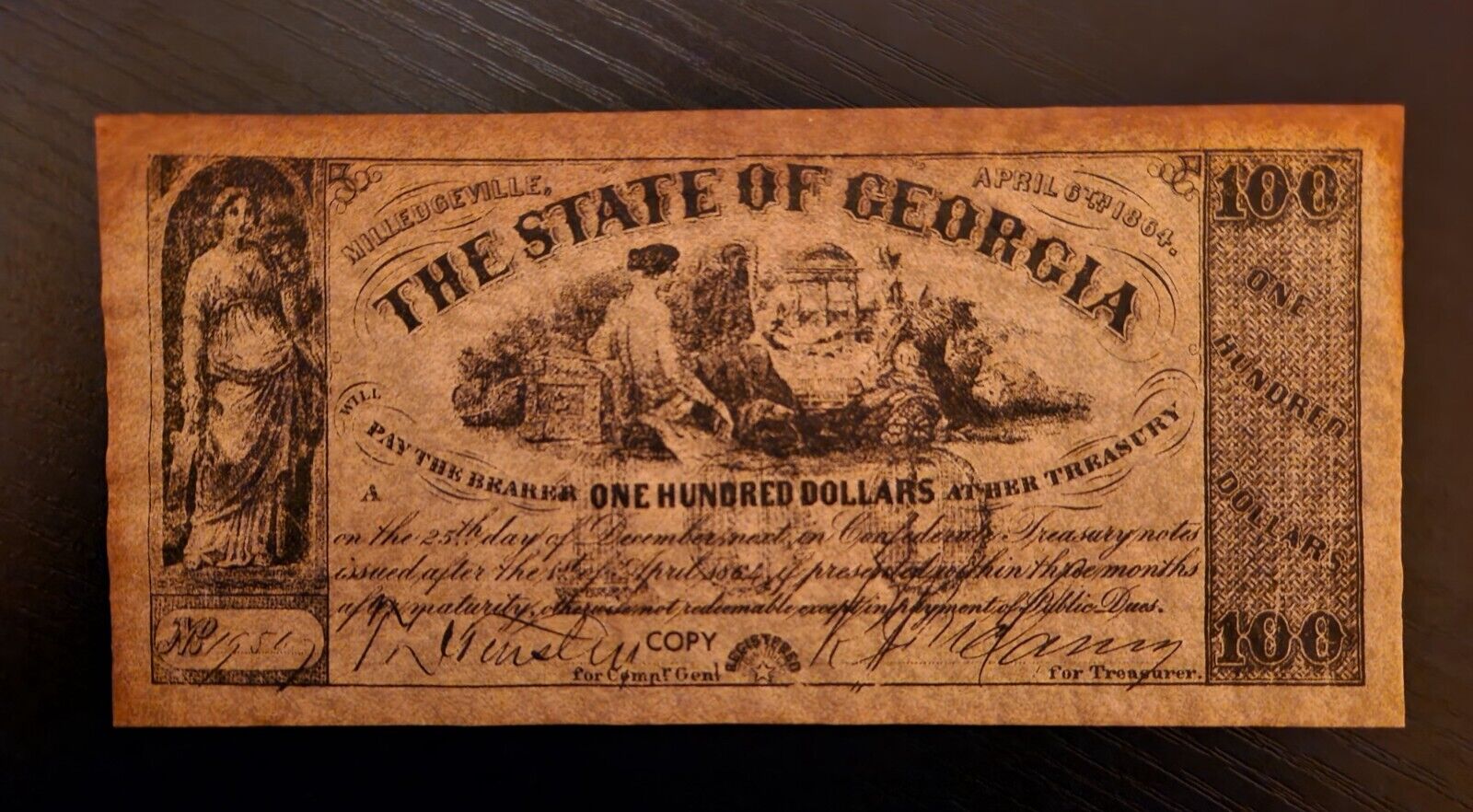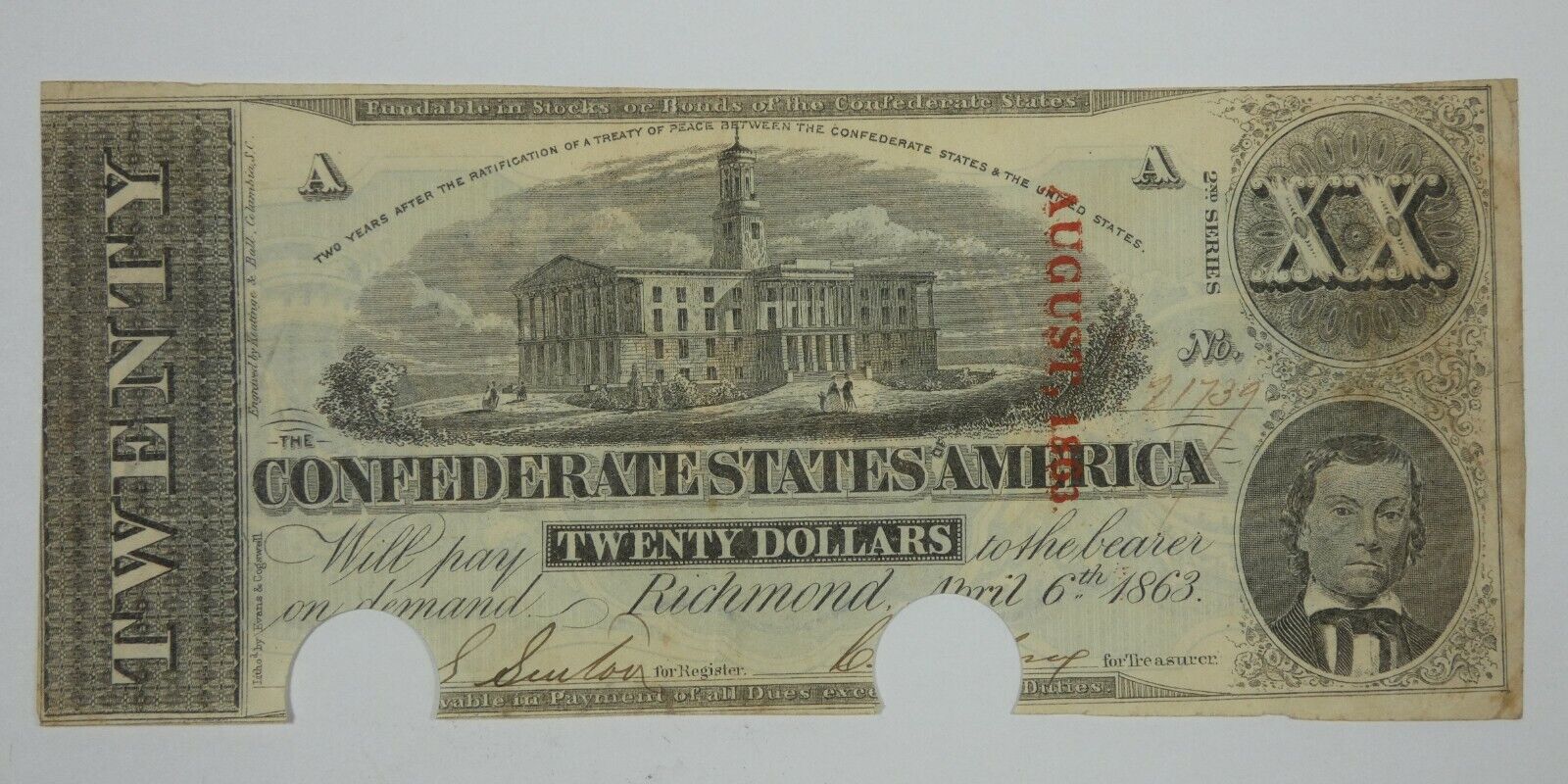-40%
T-9 PF-6 1861 Confederate Paper Money - Double Treas error!
$ 46.99
- Description
- Size Guide
Description
T-9 PF-6 .00 1861 CSA Currency.Large sailing vessel, center. Issued from July 25, 1861 through October 26, 1861.
Thick bond paper. Large XX lower right. "for Treasr" printed twice on lower corner.
Serial number 5152. Plen Cc.
Scarce!
Very Good to Fine using traditional grading.
Repaired lower right corner and small nip on bottom margin. Some repairs on the back. Faces up nice for the grade. Probably a PMG or PCGS Choice Fine 15 or Very Fine 20 Net or Details.
Genuine.
This was the first issued by the Confederacy that did not bear interest. The center vignette is that of a large sailing vessel, a vignette that appears on numerous Northern obsolete notes before the War. The note is date July 25, 1861. Receivable in payment for all dues except export dues, and fundable in Confederate States stock bearing 8% interest. The B plate version of this note is actually part of the group of notes that were first issued from Richmond.
It was during this issue that the Confederate Treasury recognized that the actual Register and Treasurer could not possibly sign all of the notes. They enlisted substitute signers and changed the notes to say “for Register” and “for Treasurer”. As this change was made after the printing of these note commenced, some that were issued had “for” written by hand, while most had “for” printed. T-9s with “for” written by hand are incredibly rare. However, Hoyer & Ludwig had difficulty with the placement of “for Treasr” as there are several error varieties within T-9.
This type comes on thick bond paper, which did not wear well. The B, C and Cc plate varieties all come on this paper, and T-9 PF-1 and PF-2 have serial numbers written in brown ink. The brown ink issues do not constitute a different variety from those described below. Thin paper was used with the Ccc and D plate notes, which also were printed on thick bond paper with the serial numbers in red.
These varieties take into account the small, medium and large “20” and “XX” to the right. T-9 PF-8 is a great classic rarity. T-9 PF-2 is a very scarce error as well. There are several other interesting errors, including an easy to identify slanted “XX” variety.
Thin paper appears somewhat transparent or translucent. You can see the design through the back when held up to a strong light. Thick bond paper appears heavier, is three times thicker, and is opaque. On notes printed on thick paper the design cannot be readily seen through the back.
T-9s are common in Uncirculated condition as many were saved by banks, and a few were saved by individuals. T-9s can be found in Choice Unc. However, they are tightly held these days, and not always available. Gem Unc. T-9s can be found and are easier than T-8.
Getting any examples of the rare varieties of T-9 is quite a feat. One should look to acquire the rare T-9s as high in the condition census as available regardless of cut or cancellations.
A note about 3rd party grading. PCGS and PMG do a good job putting a floor on quality within a grade range and have become proficient in detecting repairs (though occasionally they miss something, or see something that is not there, as we all can).
Notes housed in Net or Apparent holders have a wide range of quality from very nice (in rare cases may be nearly choice) to dogs with major problems, so each needs to be evaluated on their own.
However, PMG and PCGS focus on technical grading due to circulation and damage and do not have a mechanism for evaluating condition or eye appeal - whether a note is average, better than average, choice or gem for the grade based on its color, trim and margins. The exception to this are slabbed notes of New or Uncirculated grades to some degree. This is important as Very Fine, Extremely Fine or AU notes can have a wide range of values depending on these factors not reflected in the slab grade. A fully framed Confederate or obsolete note is worth considerably to a lot more than one that is trimmed into the margin for the same grade. Likewise, color is important. These factors can affect the value of a note by 50%, 2-1 or even 3-1, e.g., an AU 58 (PPQ or not) T-20 1861 CSA note trimmed into the margin is worth between 0 and 0. The same grade, AU 58 (PPQ or not), with a full frame and good color/inking is worth something like 0 to 00 depending on eye appeal. I will continue to use the terms plus for above average, choice and gem to mean varying degrees of superiority of condition and eye appeal of a note within a grade as documented in my book which is based on what collectors seek out and pay premiums for.
In coins, we’ve seen the third party graders add things like full bell lines, full head, full bands which reflected the market. I’d expect either the grading services or another party to do the same for paper money. If you are just buying the number on the holder for the best price, you may well be buying low end notes for the grade!
Pierre Fricke. Immediate Past President of the Society of Paper Money Collectors; Professional Numismatists Guild (PNG); Professional Currency Dealers Association (PCDA); ANA, EAC, etc...
BuyVintageMoney.
Author of the standard guide book to Confederate money - Collecting Confederate Money Field Edition 2014.
Free shipping and insurance.
eBay has announced that it will start to collect sales tax on behalf of sellers for items shipped to customers in Alabama (Jul 1), Connecticut (Apr 1), Iowa (Feb 1), Minnesota (Jan 1), New Jersey (May 1), Oklahoma (Jul 1), Pennsylvania (Jul 1), and Washington (Jan 1). Additional states are being added like Idaho and more than 20 others. This is the new internet tax out of the US Supreme Court Wayfair decision. Buyers are responsible for paying this sales tax.
See eBay information for list of states eBay charges this tax payable by buyers to eBay as part of eBay invoices -- https://www.ebay.com/help/selling/fees-credits-invoices/taxes-import-charges?id=4121#section4











